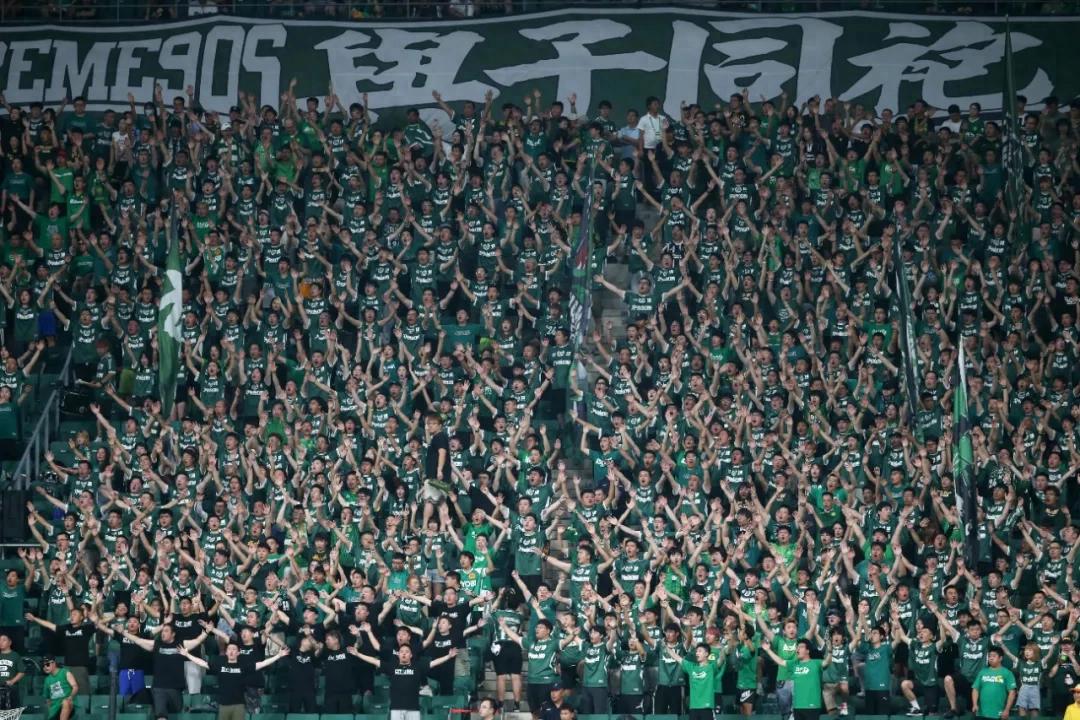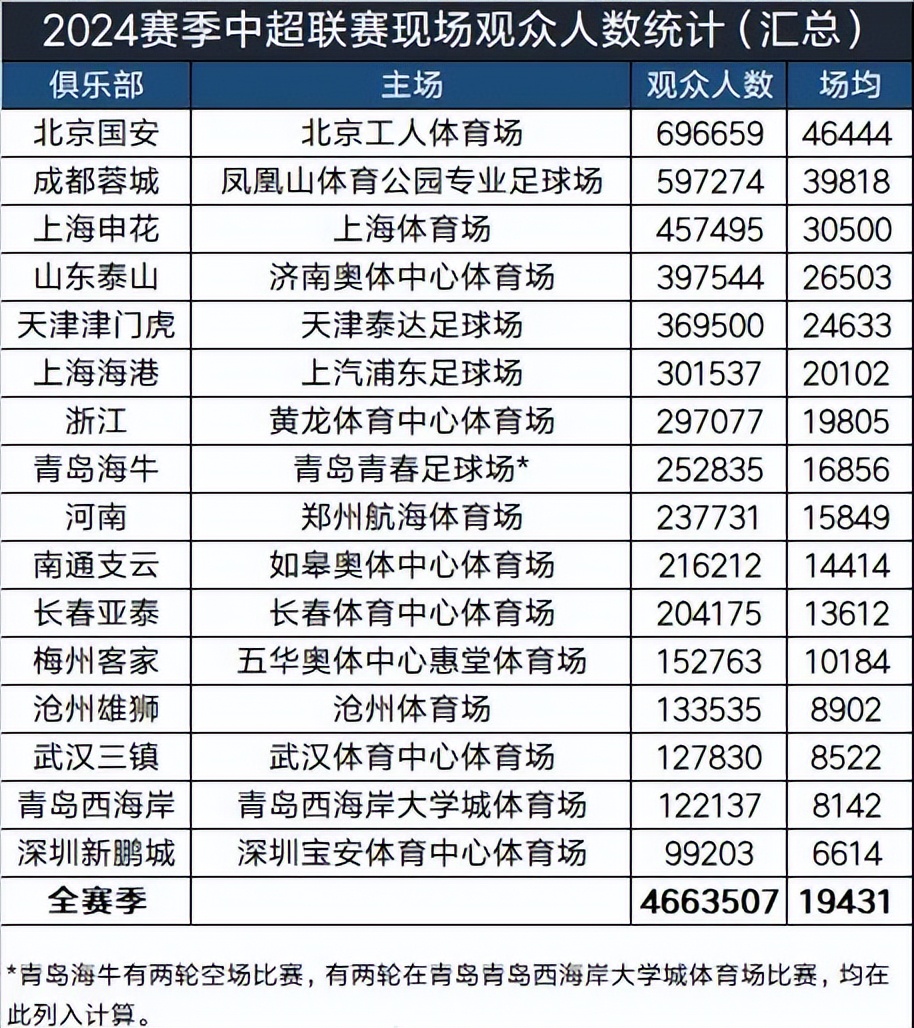The total number of spectators continues to be high, and the Chinese Super League market ranks second in Asia

The reporter reported coldly In the 2024 season, the Chinese Super League market will continue to recover, with a total of 4,663,500 spectators in the whole season, with an average of 19,400 per game. Following the full resumption of the home-and-away format of the Chinese Super League last year, it has remained at a high level of more than 4.6 million for two consecutive years. In the 21-year history of the Chinese Super League, the total number of viewers and the average number of viewers per game are second only to the "Golden Yuan Era" from 2015 to 2019. Although the total number of attendees was 104,000 fewer than last year, the overall trend was upward.
The only regret is that due to objective factors, the number of spectators per game has been surpassed by the J1 League for the first time since 2011 and ranked second in Asia. However, with the upgrading of "box office giants" Dalian InBev and Yunnan Yukun, it is expected to regain the title of No. 1 in Asia next year.

This year's Chinese Super League market is hotter than last year. The home stadiums of the six teams of Guoan, Rongcheng, Shenhua, Haigang, Zhejiang, and Cangzhou all had more spectators than last year. Its China Security continues to top the list with a total of 696,700 people, 40,000 more than last year, of which the average audience per game reached 46,400, and the highest number of spectators in a single game was 54,189 (Guoan 2 to 0 Taishan), all three data exceeded last year, and this is still under the premise that the new Gongti that can accommodate 68,000 people is only 80% of the capacity.

The data comes from Zhu Yi, the China administrator of the German transfer market website (TransferMarkt).
It is worth mentioning that there are 11 games with a single audience of more than 45,000 in the Chinese Super League this year, 10 of which are occupied by Guoan, and the remaining 1 game is Taishan 0-0 Guoan (48,397 people). The audience of more than 50,000 people in a single show for 5 times was all covered by Guoan, which shows the popularity.
Rongcheng, which ranks among the top three in the Chinese Super League this year, has the "popular home" of the Chinese Super League second only to Guoan. The total number of spectators in the whole season increased by 72,000 compared with last year, 14 of the 15 home stadiums had more than 40,000 spectators, and the Phoenix Mountain Stadium, which can accommodate 50,700 people, had an attendance rate of more than 98.7% in 14 home stadiums under the background of opening 80% of its capacity, and the average attendance rate even exceeded that of Guoan. The two games with the largest number of viewers in a single game (3-1 Xinpeng City and 0-1 Taishan) both exceeded 40,500 people and were completely full.
Due to the excellent results of Harbour and Shenhua, the number of spectators has also increased significantly compared to last year. The port increased by 68,000, with an average of more than 20,000 per game, and Shenhua increased by 62,800, with an average of more than 30,000 per game, beating Taishan to rank third in the Chinese Super League.
This year's Chinese Super League audience saw the biggest increase in attendance, Zhejiang, which hosted the Asian Games in Huzhou last year, with only 120,000 spectators entering the stadium throughout the season. This year, it moved back to Hangzhou Huanglong Stadium, and the number of spectators surged to 297,000, an increase of 2.46 times. The average audience has surged from 8,000 last year to 19,800 this year.
Taishan, Henan, Three Towns, Nantong and Meizhou have been affected by the team's poor performance, and the attendance has declined. It is commendable that Cangzhou, who is thrilling to be relegated, and the number of visitors has increased by more than 3,000 compared with last year.

The total number of visitors to the Chinese Super League this year decreased by 104,300 compared with last year, and the average number of spectators per game dropped from 19,866 to 19,431. After surpassing the J1 league in 2011, the average number of spectators per game exceeded that of the J1 League, and it was overtaken for the first time when the stadium was normally open.
This year, the J1 League has an average audience of 20,355 spectators, exceeding 20,000 for the first time since 2019, and dominating Asia again after 11 normal seasons. However, the Chinese Super League was overtaken by the J1 League this year, and there are many objective factors, which are understandable.
This season, due to the relegation and dissolution of Dalian people, it lost about 270,000 spectators; The two promoted teams from the West Coast and Xinpeng City, which moved from Sichuan to Shenzhen, contributed a total of 220,000 visitors. As a relocated team, it takes time for Xinpeng City to gather popularity in Shenzhen, and throughout the season, the audience is 20,000 fewer than last year's relegation and disbandment, and the average audience per game is only 6,600, which is at the bottom of the Chinese Super League.
In addition, the traditional box office of the Chinese Super League, the Jinmen Tigers, is located at TEDA Stadium this year, with a capacity of only 36,400. In the first half of last year, 256,600 people entered the 8 home stadiums in the water drop stadium with a capacity of 54,700, with an average audience of more than 32,000 per game, of which 3 games had more than 40,000 spectators, and the home game against Nantong also created a single record of 48,600. This year, the move to the smaller TEDA Stadium, which is also only 80% open, lost at least 50,000 spectators throughout the season.
The Manatees have been sidelined at two home games this season, and two home games were relocated to the West Coast University City Stadium for the round of 18. According to the average number of spectators per game of Manatee at Qingdao Youth Stadium, it is conservatively estimated that at least 87,000 spectators have been lost.
Taking these objective factors into account, this year's total number of Super League viewers and the average number of viewers per game should have exceeded last year.
In contrast, the J1 League has brought new stadium capacity this year compared to last year, with Tokyo Green, Hiroshima Sanfrece and Tosu Sandstone all bringing new stadium capacity. Tokyo Green, FC Tokyo, Machida Zevia, Kashima Antlers, Kobe Victory Ship and Yokohama Mariner have 11 home stadiums at the 68,000-capacity Tokyo National Stadium instead of the much smaller traditional stadiums, with at least an additional 300,000 spectators. It is precisely by placing important games in temporary home stadiums with larger capacity and releasing more spectator capacity that the average audience per game of the J1 League has exceeded 20,000 for the first time in five years.
However, next year, with the upgrading of Dalian InBev and Yunnan Yukun, the Chinese Super League will add two stable box office players. InBev played in the first division this year, with a total of 632,800 spectators at home and 283,000 in Yunnan Yukun. Promoted to the Chinese Super League next year, the attendance of the two clubs will at least remain stable, and InBev is expected to continue to break the two records of total attendance and average number of spectators per game at Barracuda Bay Stadium. Xinpengcheng moved to a new professional stadium in the center of Shenzhen, which is also expected to attract more spectators.
In this way, the total number of visitors to the new season of the Chinese Super League next year, it is not surprising that it will surpass this year, and it is not a luxury to regain the first place in Asia in terms of the average number of spectators per game.


Wonderfulshortvideo
User PlaymakerHub has posted a video.








 Links
Links
 Contact
Contact
 App
App


